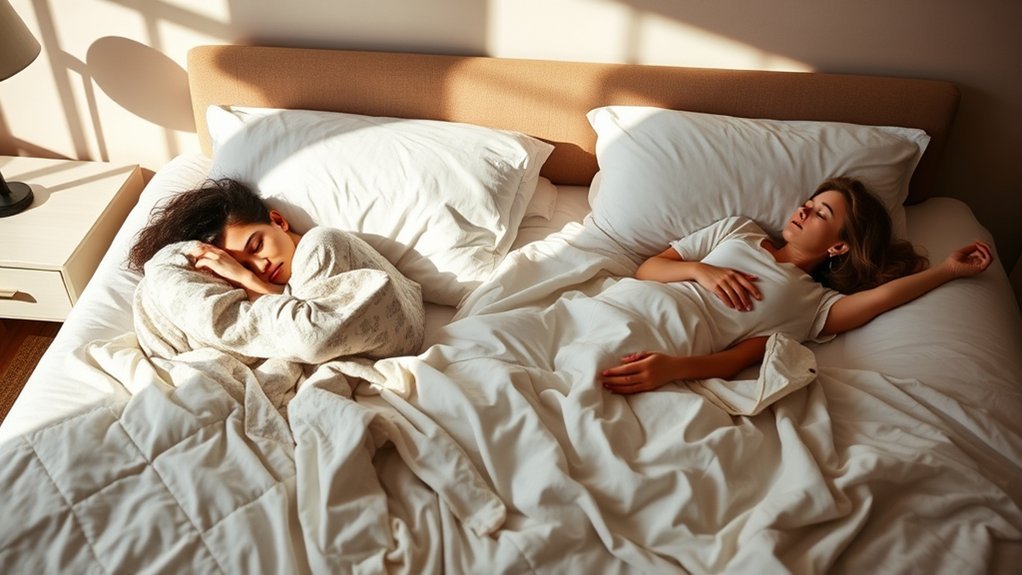Did you know that your sleep position can greatly impact your health, yet many common beliefs about them are misleading? For example, while back sleeping is often touted for spinal alignment, it can worsen snoring and sleep apnea for some people. Understanding the realities behind various sleep positions is essential for your overall well-being. Let’s explore what the science really says about these positions and how they might be affecting your sleep quality.
The Back Sleeper: Myth or Reality?

While many people believe that sleeping on your back is the best position for spinal alignment, the reality is more nuanced. Research indicates that this position can promote a neutral spine, reducing pressure on your discs. However, it’s not universally ideal.
For some, back sleeping may exacerbate snoring or sleep apnea, disrupting airflow. Additionally, if you’re prone to lower back pain, this position could lead to discomfort without proper support.
Using a supportive pillow can help maintain cervical alignment. Ultimately, the effectiveness of back sleeping depends on individual factors such as body type and existing health conditions.
It’s essential to assess how your body responds and consider alternatives if back sleeping doesn’t provide the comfort and support you need for restful sleep.
Side Sleeping: Benefits and Drawbacks

Side sleeping offers several health advantages, such as improved digestion and reduced snoring, but it can also lead to discomfort in certain positions.
You might experience shoulder or hip pain if your alignment isn’t ideal. Understanding the best side sleeping positions can help you maximize the benefits while minimizing any drawbacks.
Health Advantages of Side Sleeping
When you choose to sleep on your side, you may reveal several health benefits that can enhance your overall well-being.
Side sleeping can improve digestion, especially if you lie on your left side, as this position allows gravity to assist the digestive process. It also helps reduce acid reflux by keeping the stomach below the esophagus.
Moreover, this position may alleviate snoring and improve sleep apnea symptoms by keeping the airway open. Research indicates that side sleeping can be beneficial during pregnancy, promoting better circulation to the fetus.
Additionally, it may lower the risk of developing certain neurological conditions by enhancing brain waste clearance.
Potential Discomfort Issues
Although side sleeping presents various health benefits, it can also lead to some discomfort issues that might affect your overall sleep quality.
One common problem is shoulder pain, which arises from pressure on the shoulder joint during prolonged side sleeping. This pressure can disrupt blood circulation, leading to numbness and discomfort.
Additionally, side sleepers often experience hip pain, especially if their mattress lacks adequate support. This can result from the hip sinking too deeply, causing misalignment of the spine.
You might also find it challenging to breathe comfortably if your head isn’t elevated properly, potentially leading to snoring.
To mitigate these discomforts, consider using supportive pillows and a mattress that balances firmness and cushioning, ensuring a more restful night’s sleep.
Best Side Sleeping Positions
Finding the best side sleeping positions can greatly enhance your sleep quality while minimizing discomfort.
Here are four effective side sleeping positions you can try:
- Fetal Position: Curling your knees toward your chest can reduce snoring and alleviate back pain.
- Log Position: Sleeping with your legs straight and arms down can promote spinal alignment, but may cause shoulder stiffness.
- Yearner Position: With arms extended, this position helps open the chest and can ease breathing but might strain the shoulders.
- Relaxed Position: Placing a pillow between your legs can relieve pressure on your hips and lower back.
Each position has its benefits and drawbacks, so it’s essential to find what works best for your body’s needs.
The Fetal Position: What It Really Says About You

Curling up in the fetal position during sleep often reflects a desire for comfort and security. This position, where your knees are drawn toward your chest, can indicate a protective instinct, often linked to feelings of vulnerability or stress.
Research shows that individuals who sleep in this manner may have a more introverted personality, preferring to shield themselves from external pressures. Additionally, the fetal position can promote better spinal alignment and reduce snoring, making it a practical choice for many.
However, if you find yourself consistently sleeping this way, it might be worth considering underlying emotional states or stressors in your life. Understanding your sleep position can offer insights into your psychological well-being and personal preferences.
Stomach Sleeping: Is It Really Bad for You?
Is stomach sleeping really as detrimental as experts say? While it may feel comfortable for some, research shows it can lead to various issues.
Here are four reasons why you might reconsider this position:
- Neck Strain: Sleeping on your stomach forces your neck to twist, which can result in pain and stiffness.
- Spinal Alignment: This position can disrupt the natural curve of your spine, leading to discomfort and potential long-term issues.
- Pressure on Organs: Stomach sleeping puts pressure on essential organs, which may affect digestion and circulation.
- Sleep Quality: It can hinder your ability to achieve deep sleep stages, resulting in fatigue and poor rest.
The Impact of Sleep Positions on Health
Stomach sleeping isn’t the only position that can impact your health; the way you sleep can considerably affect your overall well-being.
Research shows that sleeping on your back can exacerbate snoring and obstructive sleep apnea, leading to disrupted sleep. On the other hand, side sleeping, particularly on your left side, may improve digestion and reduce acid reflux.
It also helps alleviate pressure on your spine, potentially reducing back pain. However, those who sleep on their sides might experience shoulder discomfort over time.
Ultimately, your sleep position can influence not just your sleep quality but also your long-term health. Choosing the right position tailored to your needs is essential for ideal rest and recovery.
Cultural Perspectives on Sleep Positions
When you explore sleep positions across different cultures, you’ll find distinct beliefs and practices that shape how people rest.
For instance, some cultures prioritize sleeping on their sides due to traditional health perspectives, while others may favor back sleeping for spiritual reasons.
Understanding these cultural nuances not only enriches your knowledge but also highlights the complex relationship between sleep positions and health outcomes.
Sleep Positions Across Cultures
Cultural beliefs and practices profoundly influence how people choose their sleep positions, revealing deeper insights into societal values and individual comfort.
You might find it interesting that sleep positions vary markedly worldwide. Here are four notable examples:
- Fetal Position: Common in many cultures, it symbolizes comfort and security, often reflecting an emotional state.
- Starfish Position: Frequently seen in Western countries, it’s linked to extroversion, as individuals in this position tend to be more open and social.
- Soldier Position: Popular in some Asian cultures, this position signifies discipline and order, mirroring societal expectations.
- Freefall Position: Adopted by some individuals in Latin America, it suggests a carefree and laid-back personality, representing cultural attitudes toward life.
Understanding these variations helps you appreciate the cultural dimensions of sleep.
Cultural Beliefs and Practices
Sleep positions often reflect a blend of cultural beliefs and practices, highlighting how societies interpret comfort and security. Different cultures emphasize various positions based on historical, spiritual, and psychological factors. For instance, in some Asian cultures, sleeping on one’s side is seen as a way to promote harmony, while Western societies might prioritize back sleeping for spinal alignment.
| Culture | Preferred Sleep Position |
|---|---|
| Japan | Side sleeping (fetal position) |
| Germany | Back sleeping |
| Brazil | Stomach sleeping |
| India | Side sleeping (often with a pillow) |
Understanding these cultural perspectives helps you appreciate the diversity in sleep practices and how they shape your nightly rest.
Impact on Health Perspectives
Though many people may not realize it, the position you choose to sleep in can greatly influence your health, reflecting deep-seated cultural perspectives.
Different cultures emphasize various sleep positions, often associating them with specific health beliefs:
- Back Sleeping: Common in Western cultures, linked to spinal alignment but might worsen snoring.
- Side Sleeping: Valued in many Asian cultures for promoting digestion and reducing acid reflux.
- Stomach Sleeping: Often discouraged due to potential neck strain, yet embraced in some cultures for comfort.
- Fetal Position: Frequently adopted for emotional security, this position is prevalent in numerous societies.
Understanding these perspectives can help you appreciate how sleep positions may impact your health and overall well-being.
Tips for Finding Your Ideal Sleep Position
Finding your ideal sleep position can greatly impact your overall health and well-being. To discover what works best for you, start by evaluating any discomfort or pain you experience.
If you wake up with back or neck pain, consider trying different positions. For instance, side sleeping with a pillow between your knees can alleviate pressure on your spine.
Back sleepers should use a supportive pillow to maintain neck alignment, while stomach sleepers might benefit from a thinner pillow to reduce strain.
Pay attention to your body’s signals; experimenting with various positions can help you identify what feels most comfortable.
Finally, make sure your mattress and pillows provide adequate support tailored to your preferred position for the best sleep quality.
Frequently Asked Questions
Can Sleep Positions Affect Dreams or Nightmares?
Yes, sleep positions can influence dreams and nightmares. Research suggests that lying on your back might increase vivid dreams, while side positions may promote more relaxed dreaming. Your body’s posture directly impacts your mental state during sleep.
How Do Pets Influence Our Sleep Positions?
When your dog’s curled up beside you, you instinctively shift to accommodate them. Research shows pets can influence sleep positions, promoting closeness and comfort, which may enhance your overall sleep quality and emotional well-being.
Is It Possible to Change My Sleep Position?
Yes, you can change your sleep position. Gradually practicing new positions, using supportive pillows, and being mindful of your body’s comfort will help you adapt over time, improving your overall sleep quality in the process.
Do Sleep Positions Impact Snoring Severity?
Yes, sleep positions can impact snoring severity. Sleeping on your back often worsens snoring due to airway obstruction, while side sleeping tends to reduce it. Experimenting with positions may help you minimize snoring and improve sleep quality.
Can Sleep Positions Affect Digestion During the Night?
Yes, sleep positions can affect digestion. Research shows that sleeping on your left side may improve digestion by allowing food to move more easily through your stomach. This position could reduce discomfort and promote better overall digestive health.
Conclusion
In conclusion, understanding the truth behind sleep positions can greatly enhance your sleep quality and overall health. Did you know that about 74% of people report improved sleep when finding their ideal position? By dispelling myths and recognizing the benefits and drawbacks of each sleeping style, you can make informed choices. Prioritizing good sleep hygiene and aligning your position with your personal needs will lead to more restful nights and better well-being.
